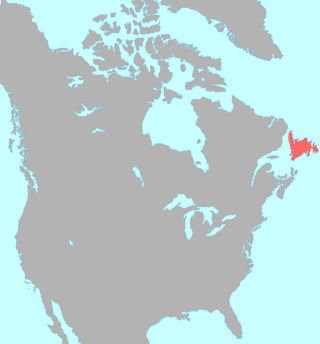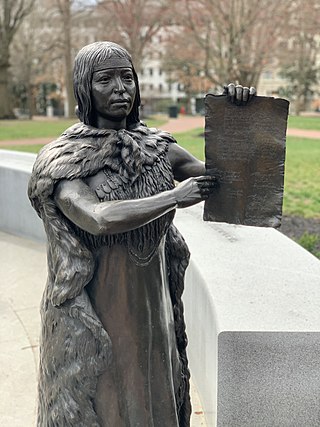Related Research Articles

The Algonquian languages are a subfamily of the Indigenous languages of the Americas and most of the languages in the Algic language family are included in the group. The name of the Algonquian language family is distinguished from the orthographically similar Algonquin dialect of the Indigenous Ojibwe language (Chippewa), which is a senior member of the Algonquian language family. The term Algonquin has been suggested to derive from the Maliseet word elakómkwik, "they are our relatives/allies".

The Powhatan people (;) are Native Americans who belong to member tribes of the Powhatan Confederacy, or Tsenacommacah. They are Algonquian peoples whose historic territories were in eastern Virginia.

The Massachusett language is an Algonquian language of the Algic language family that was formerly spoken by several peoples of eastern coastal and southeastern Massachusetts. In its revived form, it is spoken in four communities of Wampanoag people. The language is also known as Natick or Wôpanâak (Wampanoag), and historically as Pokanoket, Indian or Nonantum.

Beothuk, also called Beothukan, is an extinct language once spoken by the indigenous Beothuk people of Newfoundland. The Beothuk have been extinct since 1829, and there are few written accounts of their language. Hence, little is known about it, with practically no structural data existing for Beothuk.

Powhatan, whose proper name was Wahunsenacawh, was the leader of the Powhatan, an alliance of Algonquian-speaking Native Americans living in Tsenacommacah, in the Tidewater region of Virginia at the time when English settlers landed at Jamestown in 1607.
Proto-Algonquian is the proto-language from which the various Algonquian languages are descended. It is generally estimated to have been spoken around 2,500 to 3,000 years ago, but there is less agreement on where it was spoken. The Algonquian family, which is a branch of the larger Algic language family, is usually divided into three subgroups: Eastern Algonquian, which is a genetic subgroup, and Central Algonquian and Plains Algonquian, both of which are areal groupings. In the historical linguistics of North America, Proto-Algonquian is one of the best studied, most thoroughly reconstructed proto-languages. It is descended from Proto-Algic.

The Pamunkey Indian Tribe is one of 11 Virginia Indian tribal governments recognized by the Commonwealth of Virginia, and the state's first federally recognized tribe, receiving its status in January 2016. Six other Virginia tribal governments, the Chickahominy, the Eastern Chickahominy, the Upper Mattaponi, the Rappahannock, the Monacan, and the Nansemond, were similarly recognized through the passage of the Thomasina E. Jordan Indian Tribes of Virginia Federal Recognition Act of 2017 on January 12, 2018. The historical people were part of the Powhatan paramountcy, made up of Algonquian-speaking nations. The Powhatan paramount chiefdom was made up of over 30 nations, estimated to total about 10,000–15,000 people at the time the English arrived in 1607. The Pamunkey nation made up about one-tenth to one-fifteenth of the total, as they numbered about 1,000 persons in 1607.

The Eastern Algonquian languages constitute a subgroup of the Algonquian languages. Prior to European contact, Eastern Algonquian consisted of at least 17 languages, whose speakers collectively occupied the Atlantic coast of North America and adjacent inland areas, from what are now the Maritimes of Canada to North Carolina. The available information about individual languages varies widely. Some are known only from one or two documents containing words and phrases collected by missionaries, explorers or settlers, and some documents contain fragmentary evidence about more than one language or dialect. Many of the Eastern Algonquian languages were greatly affected by colonization and dispossession. Miꞌkmaq and Malecite-Passamaquoddy have appreciable numbers of speakers, but Western Abenaki and Lenape (Delaware) are each reported to have fewer than 10 speakers after 2000.

The Native American tribes in Virginia are the Indigenous peoples whose tribal nations historically or currently are based in the Commonwealth of Virginia in the United States of America.
Powhatan or Virginia Algonquian was an Eastern Algonquian subgroup of the Algonquian languages. It was formerly spoken by the Powhatan people of tidewater Virginia. Following 1970s linguistic research by Frank Thomas Siebert, Jr., some of the language has been reconstructed with assistance from better-documented Algonquian languages, and attempts are being made to revive it.
The Nansemond are the Indigenous people of the Nansemond River, a 20-mile-long tributary of the James River in Virginia. Nansemond people lived in settlements on both sides of the Nansemond River where they fished, harvested oysters, hunted, and farmed in fertile soil. Today, Nansemond people belong to the federally recognized Nansemond Indian Nation.

The Mattaponi tribe is one of only two Virginia Indian tribes in the Commonwealth of Virginia that owns reservation land, which it has held since the colonial era. The larger Mattaponi Indian Tribe lives in King William County on the reservation, which stretches along the borders of the Mattaponi River, near West Point, Virginia.

Cockacoeske was a 17th-century leader of the Pamunkey tribe in what is now the U.S. state of Virginia. During her thirty-year reign, she worked with the English colony of Virginia, trying to recapture the former power of past paramount chiefs and maintain peaceful unity among the several tribes under her leadership. She was the first of the tribal leaders to sign the Virginia-Indian Treaty of Middle Plantation. In 2004 Cockacoeske was honored as one of the Library of Virginia's "Virginia Women in History".

The Nottoway are an Iroquoian Native American tribe in Virginia. The Nottoway spoke a Nottoway language in the Iroquoian language family.

Carolina Algonquian was an Algonquian language of the Eastern Algonquian subgroup formerly spoken in North Carolina, United States.

Narragansett is an Algonquian language formerly spoken in most of what is today Rhode Island by the Narragansett people. It was closely related to the other Algonquian languages of southern New England like Massachusett and Mohegan-Pequot. The earliest study of the language in English was by Roger Williams, founder of the Rhode Island colony, in his book A Key Into the Language of America (1643).
The phonology of the Massachusett language was re-introduced to the Mashpee, Aquinnah, Herring Pond and Assonet tribes that participate in the Wôpanâak Language Reclamation Project, co-founded by Jessie Little Doe Baird in 1993. The phonology is based regular sound changes that took place in the development of Proto-Eastern Algonquian from Proto-Algonquian, as well as cues in the colonial orthography regarding pronunciation, as the writing system was based on English pronunciation and spelling conventions in use at the time, keeping in mind differences in late seventeenth century English versus today. Other resources included information from extant Algonquian languages with native speakers.
The Nansemond language is an extinct language that was spoken by the Nansemond people of Virginia, United States.
References
- ↑ "Archived copy" (PDF). Archived from the original (PDF) on 2018-12-31. Retrieved 2018-12-31.
{{cite web}}: CS1 maint: archived copy as title (link) - ↑ Howell, Benita J.; Levy, Richard S.; Luckenbach, Alvin (1979). "What is Dalrymple's Pamunkey?". International Journal of American Linguistics. 45: 78–80. doi:10.1086/465576. S2CID 143441104.
- ↑ A Vocabulary of Powhatan, compiled by Captain John Smith, with two word-lists of Pamumkey and Nansemond from other sources. Evolution Publishing, 1997.
- ↑ Zamponi, Raoul (2024). "Unclassified languages". The Languages and Linguistics of Indigenous North America. De Gruyter. pp. 1627–1648. doi:10.1515/9783110712742-061. ISBN 978-3-11-071274-2.
- ↑ Hewson, John. 1993. A computer-generated dictionary of Proto-Algonquian. Hull: Canadian Museum of Civilization.
- ↑ Julian, Charles. 2010. A history of the Iroquoian languages. Winnipeg: University of Manitoba Ph.D. dissertation.
- ↑ Rankin, Robert L., Richard T. Carter, A. Wesley Jones, John E. Koontz, David S. Rood & Iren Hartmann (eds.). 2015. Comparative Siouan dictionary . Leipzig: Max Planck Institute for Evolutionary Anthropology. Accessed 31 January 2023.
- ↑ Benita Howell, Richard Levy & Alvin Luckenbach, 'What Is Dalrymple's Pamunkey?', International Journal of American Linguistics, vol. 45, no. 1 (Jan. 1979), pp. 78–80